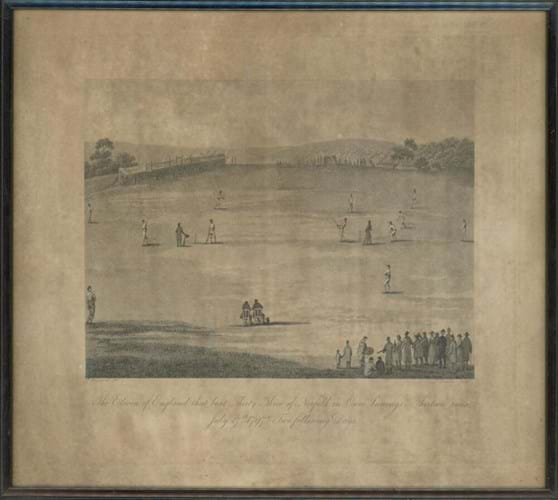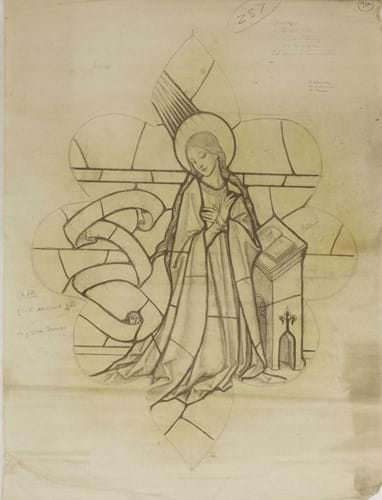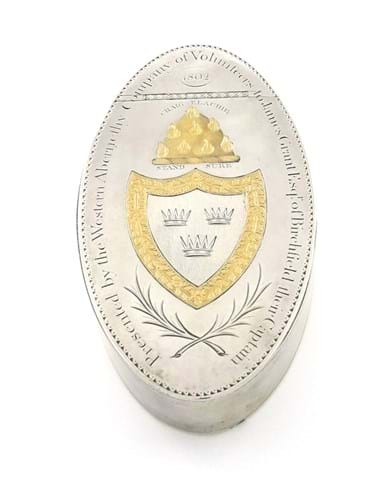1. Sarah Biffin portrait
The July 8 Fine & Classic auction sale at Wilson55 in Nantwich included this portrait miniature by Sarah Biffin (1784-1850) (pictured above). Born with the congenital deformity phocomelia, she taught herself to write, paint and hold scissors using her mouth and spent her formative years touring the country as 'the limbless wonder’ as part of Emmanuel Dukes’ travelling show. It was at St Bartholomew’s Fair in 1808, that she was introduced to Earl of Morton, an encounter that led to professional training, aristocratic patronage and ultimately recognition by the Royal Academy.
Biffin’s story of talent and triumph over adversity is slowly becoming better known. The sale at Sotheby’s in December 2019 of a self-portrait for a multi-estimate £110,000 was a ‘sit up and take notice’ moment in the collecting market: hitherto the previous auction high for Biffin was the £1600 bid at Bonhams Knightsbridge in 2009 for A Lady, seated in a red upholstered chair. This does appear to be changing. Here an oval watercolour on ivory miniature of a Regency era military officer, with inscribed label and printed biography verso, came for sale from a Cheshire estate with the guide of £300-500. It attracted a huge amount of interest from collectors before the hammer fell at £5800.
2. Famous cricket match engraving

'The Eleven of England that beat Thirty-Three of Norfolk in One Innings & Thirteen runs' - £4000 at Knights Sporting Auctions.
This engraving documents a once famous cricket match played between an England 11 and a Norfolk side of 33 men in 1797. The game took place on Swaffham Racecourse over three days in front of a crowd who watched the numerically stronger home team fall to a crushing innings defeat.
After England had scored 144, Norfolk managed a total of just 130 from two innings of 50 and 80 runs. Only one Norfolk batsman made it to double figures (14) and of the 64 wickets taken by the English attack, 35 were ducks.
This humiliation of the local talent did, nonetheless, help fire the appetite for cricket in Norfolk that by 1827 had formed its own county club. The print, measuring 15 x 13in (37 x 32cm), is titled simply The Eleven of England that beat Thirty-Three of Norfolk in One Innings & Thirteen runs, July 17, 1797 & Two Following Days and includes the imprint of the London printers G Shepheard and J Dadley. There was staining to the entire image but, offered by Norwich firm Knights Sporting Auctions on July 9, it improved on a £300-400 estimate to bring £4000.
3. Georgian Newmarket print
Another rare Georgian print on a sporting theme was offered by Wooler, Northumberland firm Railtons on July 9-10. John Chapman’s A Plan of the Town of Newmarket, dated March 31, 1787, is of primary interest for a key that lists the stables owned by ‘Noblemen & Gentlemen’, many of them important figures in the history of the Turf.
This is a second version of this 22 x 18in (55 x 45cm) print that was first issued by local mapmaker Chapman in c.1768. The original plates were sold along with the rest of Chapman's stock-in-trade after his widow's death in 1784 when they were acquired by the Charing Cross printer William Faden who reissued them with a few alterations.
The picture lower left of the famous racehorse Eclipse was unchanged (the undefeated thoroughbred had in fact retired in 1771) but the list of aristocratic stable owners was updated.
That it is headed by the Prince of Wales dates the print to the period 1787-91. It was in 1791 that the Jockey Club accused the Prince's jockey of race fixing after he pulled up his horse Escape in one race in order to secure favourable odds in another. To avoid further scandal the Prince sold all his racehorses.
Chapman's maps are frequently mentioned in histories of both Newmarket and the Turf, but few copies of either the 1768 or the 1787 editions of A Plan of the Town of Newmarket have appeared for sale before. This one, offered at just £30-40, sold to a buyer via thesaleroom.com at £2600.
4. Cartoon for stained glass
Sworders’ Design sale included a collection of cartoons for stained glass by George Daniels (1854-1940). His work is seen in many English cathedrals, including Lichfield, Gloucester, York, Ely and Truro, as well as in hundreds of parish churches throughout the UK and overseas.
These full-size working drawings, for sale on July 13, were made in the 1920s and 1930s when Daniels, in his 70s, was working with the architect Frederick Charles Eden (1864-1944). The pair shared an appreciation of later medieval and early Northern Renaissance art and worked on a wide range of projects.
Most of these pencil cartoons were created for extant stained glass windows in Cambridgeshire and Suffolk churches. Pictured here is on of five drawings made for a Chedburgh Church, Suffolk in 1925: three on the theme of the Annunciation and two others on the Crucifixion. The group sold at £1500.
5. Snuff box
The silver sale at Woolley & Wallis on July 13 included a selection of 24 snuff boxes from the Lion collection as published in British Silver Boxes 1640-1840, The Lion Collection (2015).
This particular parcel gilt table snuff box, bought at Christie's South Kensington in 2006, is by Alexander Gardner and Co, Edinburgh 1802. Alongside an armorial is a presentation inscription reading Presented by the Western Abernethy Company of Volunteers to James Grant Esq. of Birchfield their Captain.
The unit was among those raised during the Napoleonic Wars. Grant, who in 1793 had created a regiment of Fencibles almost exclusively from his own tenantry, raised the Strathspey Battalion of Volunteers in 1798. In Abernethy there were two companies, the Eastern and the Western, the latter with 80 men. Estimated at £2000-3000 it proved among the most desirable of the 24 boxes selling at £4200.









